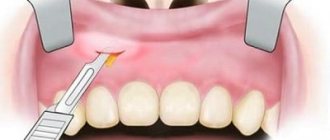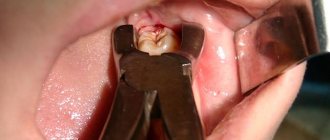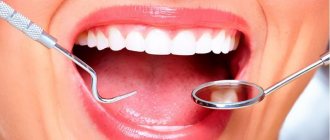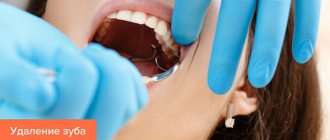Usually, the healing of the hole after tooth extraction occurs painlessly and does not cause any sensations in the patient. It would be good if everyone knew how this process works and how to speed it up.
Proper oral care after tooth extraction and following all the dentist’s recommendations will help speed up the healing of the hole and avoid complications.
Stages of socket healing by day
- The bleeding that occurs after tooth extraction stops after a few minutes , and a blood clot is formed that protects the wound from the penetration of microbes. Under the clot, damaged tissue is being restored, so it is so important to maintain its integrity until the hole heals completely.
- Day 1 – the processes of epithelization (healing) of the wound surface begin.
- Day 3 - signs of epithelization become noticeable, healing begins from the edges of the wound and moves towards the center.
- Day 4 - granulation tissue begins to form - a type of connective tissue that is formed in the body only during wound healing by secondary intention, when there is a strong defect in the skin.
- Day 7 - granulation tissue replaces part of the blood clot, it remains only in the center of the hole. Osteoid (bone) beams begin to appear, indicating bone formation. At the same time, epithelial tissue grows significantly from the edges of the gums.
- 14th -18th day - epithelization of the wound is completely completed, its surface is tightened and heals completely. By this time, the hole is completely filled with granulation tissue, and osteoid tissue is actively developing.
- After a month, a significant part of the hole is filled with new bone tissue. By the end of the second, sometimes third month, this process is completely completed.
- 4th month - bone beams in the newly formed osteoid tissue calcify, it matures: it becomes spongy and does not differ from the rest of the bone. At the same time, the edges of the socket dissolve, the alveolar edge in the area of the extracted tooth becomes thinner and lower than it was before surgery.
What symptoms bother a person?
The first signs of alveolitis (see photo) appear 3–4 days after the procedure. Noted:
- swelling and redness of the gums in the area of damaged tissue;
- unpleasant odor from the mouth;
- severe increasing pain spreading to nearby areas and tissues;
- high temperature (38–39 °C);
- malaise;
- absence of a blood clot in the socket;
- the formation of a grayish coating on the socket and the absence of a blood clot;
- separation of pus from the socket;
- enlarged lymph nodes;
- swelling of the cheek (not always).
Some symptoms appear in the initial stages of alveolitis development, others - severe pain, high fever, swollen lymph nodes and the separation of pus from the socket indicate a severe stage of inflammation. Therefore, any manifestations of alveolitis should be a reason to consult a doctor.
Healing of the socket with gum inflammation
If tooth extraction was carried out against the background of inflammation, or the inflammatory process in the gums developed later, epithelization of the wound begins on the 10th -14th day, bone beams appear only by the 15th day. A significant part of the socket is filled with young osteoid tissue only by the end of the second month.
After a complex tooth extraction, when the gums rupture and the walls of the socket are traumatized, the edges of the gums cannot come together for a long time and the epithelization process slows down. Wound healing can only be completed after 1-1.5 months. In this case, the development of new bone tissue is delayed.
Granuloma on the root of the tooth - causes of appearance
There are only 2 main reasons for the occurrence of granulomas at the apexes of tooth roots. These reasons occur in 98% of cases, and we have described them in detail below. Much less often, granulomas are formed as a result of poor-quality orthodontic treatment, or mechanical trauma to the tooth (after an impact).
- As a consequence of untreated pulpitis (Fig. 4) - when the carious cavity of the tooth becomes deep enough - cariogenic microorganisms penetrate into the dental pulp, causing inflammation in it (it is called pulpitis). This is accompanied by sharp or aching pain. If the tooth is not treated at this stage, the nerve in the tooth dies and the pain temporarily stops.
After the death of the nerve, pathogenic microorganisms penetrate through the root canals and openings at the apex of the roots - beyond the boundaries of the tooth. This leads to the formation of foci of inflammation at the apexes of the roots (24stoma.ru). This disease is called periodontitis. There are several types of this disease, in one of which granulomas form at the tops of the roots.Keep in mind that in this case the tooth does not necessarily have to have a carious cavity, because Inflammation of the nerve in a tooth can also occur in a tooth previously treated for caries. This happens if the doctor has not completely removed the tissue affected by caries, leaving a small fragment of it under the filling (Fig. 5). In this case, caries develops under the filling and leads to the development of first pulpitis, and then periodontitis with granuloma.
- Poor-quality root canal filling - if a granuloma has formed on the root of a tooth in which root canals were previously filled (for example, during the treatment of pulpitis), then there is only one reason for its formation!
This reason is poor-quality filling of the canals, or more precisely, the fact that the root canals were not filled to the apex of the root (Fig. 6). If your doctor says that the canals are sealed well, and he does not know why a granuloma appeared after treatment, then such a doctor is lying. “The tooth is filled well, take antibiotics” - this is a standard excuse from doctors who do not want to admit to poor-quality work and, at the same time, treat the tooth for free.
How to speed up the healing of a hole
To speed up the healing of the hole after tooth extraction, you need to follow these rules:
- Do not touch the blood clot on the socket with your tongue, much less with your hands or a toothpick, so as not to damage it. The presence of a clot is a guarantee of speedy healing of the wound.
- For three hours after visiting the dentist, you should not eat or rinse your mouth. Compliance with this point will also help maintain the integrity of the blood clot.
- · Drinks and food should not be too hot or cold for several days after removal. The food chosen is soft, without coarse inclusions, to prevent injury to the gums.
- You should not engage in heavy physical work for several days to avoid opening the wound and resuming bleeding.
- Since tobacco smoke and alcohol irritate the mucous membrane and inhibit the healing of the hole, you need to stop smoking and drinking alcohol for a while.
- To prevent infection from entering the wound and reduce inflammation after a traumatic tooth extraction, antiseptic baths are used. For them, solutions of chlorhexidine or furatsilin, infusions of sage, chamomile, and eucalyptus are used. The solutions are taken into the mouth, held for several minutes and carefully spat out.
- On the third day after removal, you can carry out antiseptic rinses with the same agents.
- Taking anti-inflammatory drugs (nimesulide, ibuprofen) will help not only eliminate pain, but also relieve the inflammatory process, which also helps accelerate socket regeneration.
- If the doctor has prescribed antibiotics, you should not refuse them, since eliminating the microbial infection shortens the healing time.
- When brushing your teeth, be careful not to touch the wound with the brush.
- To speed up healing, you can use Solcoseryl dental paste. It enhances intracellular energy exchange, due to which cell regeneration and restoration of damaged tissues are accelerated. Solcoseryl also creates conditions for the growth of granulation tissue. The paste is applied to a previously dried surface, then moistened with water. Before using the medicine, it would be more correct to ask your dentist about when to start using Solcoseryl after tooth extraction and how many times a day to apply it to the gums.
Diagnosis and treatment
To make a diagnosis, the doctor will definitely send you for an x-ray. The identification of small darkened areas with a rounded shape in the image indicates that the patient has developed a granuloma.
Depending on the size of the formation, the general condition of the dental tissues, the presence of complications and other factors, the doctor chooses treatment methods:
- Therapeutic. Granuloma diagnosed in the early stages can be cured with a course of antibiotics and sulfa drugs. Antibiotics should only be selected by a doctor, since the wrong drug or dosage can only worsen the situation.
- Surgical. In the later stages, it is important to carefully scrape out the cavity and drain the pus from it to prevent the infection from spreading to healthy tissues and organs. To do this, excision of the granulation is performed, followed by curettage. The wound is left open and drainage is installed. This helps to completely drain the purulent contents. At the same time, conservative therapy is carried out aimed at eliminating the infection.
Despite the effectiveness of such treatment methods, it is not always possible to save a tooth. Indications for removal are various complications, for example, a root crack or multiple perforation, severe tooth decay.
If you have the symptoms described in this article, be sure to make an appointment at our clinic.
Don't self-medicate! Even the smallest problem, if not treated correctly, can significantly complicate your life.
By contacting us, you can be sure that:
- Get high-quality and free consultation .
- You will receive the best prices for treatment and the opportunity to receive a special promotional price.
- Only modern equipment and materials will be used.
- You will be treated by professional doctors with many years of experience.
- We offer treatment on credit or in installments. There is also the possibility of obtaining a tax deduction.
- We work seven days a week and without a lunch break, from 9 a.m. to 10 p.m.
+7 (495) 132-02-96
Make an appointment
What to do when the hole has healed?
After the hole has healed and filled with full bone tissue, it is necessary to take care of restoring the dentition. The absence of even one tooth can lead to displacement of the remaining teeth, changes in bite, diction, aesthetic problems, and resorption (atrophy) of bone tissue at the site of the extracted tooth. A tooth can be restored using implantation, when an artificial root is implanted into the bone and a crown is installed on it. This method of prosthetics is by far the most comfortable and effective for the patient.
If bone tissue atrophy has already occurred, bone tissue augmentation is performed before installing the implant. The procedure allows you to perform high-quality prosthetics and restore the functionality and aesthetics of your teeth.
Why does a wound take a long time to heal after tooth extraction?
Ripping out a destroyed unit is a very traumatic process. This operation is comparable to any other surgical procedure. The tissue surrounding the removed roots is severely damaged. The integrity of the periodontal and periodontal zones is compromised.
Microtears of ligaments and destruction of individual nerve bundles are observed. The injured area swells, turns blue, swells, and becomes painful to the touch. It is clear that in such a situation regeneration cannot be lightning fast. It should be understood that how long it takes for gums to recover depends on many factors:
- person's age;
- an illness that necessitated dental surgery;
- characteristics of the patient's health status;
- the presence of concomitant pathologies of a systemic nature in the patient;
- the complexity of the surgical procedures being performed;
- experience of a dental surgeon;
- the need for sutures;
- the number of roots in the tooth being pulled out;
- features of the location of the unit in the dentition.
Removal of the lower impacted figure eight
A common complication is wisdom tooth retention, which is incomplete eruption. It can erupt above the gum as part of the crown or as one or two bumps. In this case, the second part of the crown will be covered with a gingival hood. With insufficient hygienic care, food accumulation, gum inflammation, and pericoronitis (inflammation of the hood) occur. In the case of pericoronitis, the dentist excises or cuts the gingival hood. But if the situation is constantly repeated and bothers you, then it is better to remove such a tooth. Chronic inflammation of the gums is a source of infection that spreads throughout the body and can provoke an exacerbation of other diseases.
What determines the speed of regeneration?
All people want their mouth wound to heal as quickly as possible. But sometimes recovery takes longer. The speed of recovery processes is reduced:
- poor oral hygiene;
- associated jaw injuries;
- poor-quality tooth extraction (if there are root particles left in the hole);
- development and progression of gingivitis, periodontitis;
- decreased immunity;
- avitaminosis;
- diabetes;
- cavity infection;
- decreased blood clotting;
- hormonal disorders.
In order not to suffer from a slowly healing wound, prepare for the operation competently and follow the doctor’s instructions after it. Then very soon your gum will look like the healthy tissue surrounding it.











